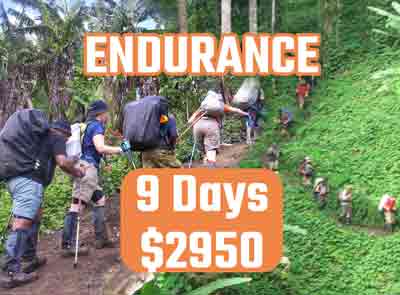Comprehensive Guide to Common Hiking Injuries on the Kokoda Trail
Introduction
Embarking on the Kokoda Track is an exhilarating experience, offering trekkers breathtaking views and a journey through historical wartime landscapes. While the adventure is undoubtedly rewarding, it’s crucial to be aware of potential hiking injuries that may arise during your trek. In this comprehensive guide, we’ll delve into common hiking injuries, their prevention, and how to address them with proper first aid.
Common Hiking Injuries on the Kokoda Track
1. Foot Injuries
Blisters: The Hiker’s Nemesis
Blisters are one of the most common issues faced by trekkers. The constant friction between your hiking boots and feet can lead to painful blisters. To prevent them, ensure your boots fit well, use moisture-wicking socks, and employ blister prevention techniques.
2. Knee Pain
Knee pain is another common cause of discomfort during trekking. Proper knee support, using hiking poles, and maintaining good hiking posture can help prevent this issue.
3. Ankle Sprains
Uneven terrains can pose a risk of ankle sprains. Choosing appropriate footwear, strengthening ankle muscles, and using trekking poles can significantly reduce the likelihood of sprains.
4. Dehydration and Heat-Related Issues
Stay Hydrated to Avoid Dehydration
Dehydration is a common risk while trekking, especially in hot weather. Drink plenty of water, use electrolyte supplements, and be mindful of signs of heatstroke. Applying sunscreen and wearing long pants can protect against sunburn.
First Aid Tips for Hiking Injuries
1. Immediate Actions for Common Injuries
Blisters: Treat and Prevent
Carry a well-equipped first aid kit that includes blister treatment essentials. Apply moleskin or blister pads to alleviate pain and prevent further friction.
2. Sprains and Strains
In case of ankle sprains or muscle cramping, use the R.I.C.E. method – Rest, Ice, Compression, and Elevation. A properly stocked first aid kit should include elastic bandages for immediate use.
3. Dehydration and Heat-Related Illnesses
Know the Signs
Recognize the signs of dehydration and heat-related illnesses, such as dizziness, nausea, or excessive sweating. Take immediate action by drinking more water, resting in the shade, and using electrolyte supplements.
Prevention Strategies for a Safe Trek
1. Gear Essentials
Invest in Quality Hiking Gear
Properly fitting hiking boots, moisture-wicking socks, and a well-adjusted backpack are essential for a comfortable trek. Use hiking poles to distribute body weight and reduce strain on your joints.
2. Hydration and Nutrition
Drink Plenty of Water
Staying hydrated is paramount. Drink water consistently, even if you don’t feel thirsty. Include electrolyte-rich beverages to maintain a balance.
3. First Aid Preparedness
Wilderness First Aid Knowledge
Equip yourself with basic first aid skills and carry a comprehensive first aid kit. Know how to address common injuries to ensure a prompt response in case of emergencies.
4. Proactive Foot Care
Keep Your Feet Dry
Moisture can contribute to blisters. Use moisture-wicking socks, apply talcum powder, and change socks if they become damp to keep your feet dry.
Conclusion
Hiking the Kokoda Track is a remarkable adventure that demands preparation and caution. By understanding common hiking injuries and adopting preventive measures, you can ensure a safer and more enjoyable trek. Remember to stay vigilant, take necessary precautions, and be prepared for any challenges that may arise on this historic trail. Happy trekking!
FAQ’s
Q: What are the most common hiking injuries on the Kokoda Trail?
A: The most common hiking injuries on the Kokoda Trail include blisters, sprained ankles, sunburn, and heat-related illnesses such as heat stroke.
Q: How can I prevent blisters while hiking?
A: To prevent blisters while hiking, wear proper-fitting hiking socks, keep your feet dry, and use moleskin or blister bandages as soon as you feel any discomfort or rubbing on your feet.
Q: What should I include in my hiking first aid kit?
A: Your hiking first aid kit should include essentials such as bandages, antiseptic wipes, moleskin for blisters, pain relievers, and any personal medications you may need.
Q: What are effective ways to prevent and treat common hiking injuries and illnesses?
A: Effective ways to prevent and treat common hiking injuries include stretching before hiking, staying hydrated, taking regular breaks, and knowing when to seek medical attention for more serious injuries.
Q: How can I help prevent heat-related illnesses while hiking in hot weather?
A: To help prevent heat-related illnesses while hiking in hot weather, drink plenty of water, wear lightweight and breathable clothing, take breaks in shaded areas, and be mindful of your body temperature.
Q: What should I do if I experience a hiking injury that is difficult to prevent?
A: If you experience a hiking injury that is difficult to prevent, such as a sprained ankle, it’s important to rest, elevate the affected area, and apply ice if possible. If the pain persists, seek medical attention.
Q: What are some common reasons for hikers to experience stomach aches while hiking?
A: Common reasons for hikers to experience stomach aches while hiking include dehydration, consuming unfamiliar food or water, and exerting themselves for extended periods of time without proper nutrition.
Q: Is it necessary to see a doctor for hiking-related injuries and how to treat them?
A: It is advisable to see a doctor for hiking-related injuries if the pain is severe, the injury is preventing you from continuing your hiking experience, or if you notice any signs of infection or persistent discomfort.
Q: What are some preventive measures to avoid common hiking injuries altogether?
A: Some preventive measures to avoid common hiking injuries altogether include wearing proper footwear, knowing your limits, staying aware of your surroundings, and having a hiking buddy for support and assistance.
Q: What are effective methods to prevent dehydration while hiking for extended periods of time?
A: Effective methods to prevent dehydration while hiking for extended periods of time include drinking water regularly, eating snacks with electrolytes, avoiding excessive caffeine and alcohol, and recognizing early signs of dehydration.




